Are MONAT Ingredients Safe? (MONAT Hair Products Review)
Are MONAT ingredients safe? A reader sent me an article alleging that the ingredients in MONAT hair products are toxic. I spent some time going through all the claims. This post is my rebuttal.

Are MONAT ingredients safe? A reader sent me an article alleging that the ingredients in MONAT hair products are toxic. I spent some time going through all the claims. This post is my rebuttal.
If you’re overwhelmed by science techno-babble, don’t worry, I break it down for you and make it easy to digest. I think you’ll be surprised by what the science clearly shows…
My Disclaimer
Before I begin this post, I will make a disclaimer to disclose any bias. I am an independent MONAT Market Partner, which means I sell MONAT products and earn commissions. That said, I never promote anything I don’t believe in, and if I find out something is not up to snuff, I discontinue promoting it.
In fact, read the series of posts and watched the many videos I did on the fermented cod liver oil scandal. I used to promote and make money from Green Pastures’ fermented cod liver oil, but after Kaayla Daniel’s whistleblower report, I was extremely vocal about my disavowal of that product and cut all ties with the company that manufactures it.
Are MONAT Ingredients Safe?
In the Ancestral Nutrition post, the author claimed that MONAT hair products are toxic and that MONAT hair products contain harmful ingredients.
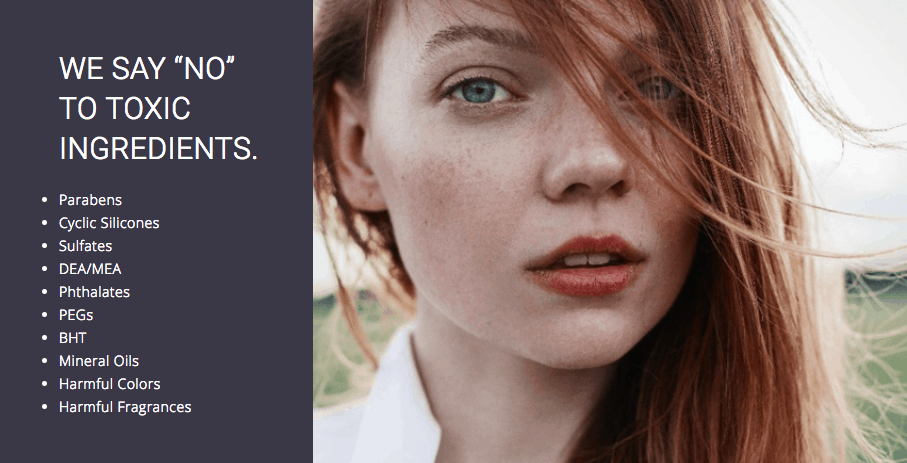
She writes:
“Because fragrance is on the ingredient label of several MONAT products. No pthalates? Pthalates are often hiding under the umbrella term of “fragrance.” No PEGs? Then what about steareth-21 or ceteareth-20? Both are PEGs and both are found in MONAT products. The fact that this company lists the ingredients as toxins shows they know that they are harmful, but then they go on to have the audacity to use them in their products! This is not okay. It’s flat out dishonesty and women need to know.”
Let me start by saying that I have nothing personal against the author of the Ancestral Nutrition blog. I don’t know her personally.
My rebuttal is purely based on refuting factual errors. Also, her article is absolutely riddled with errors. She even got the ingredients wrong on the Rejuveniqe Oil:
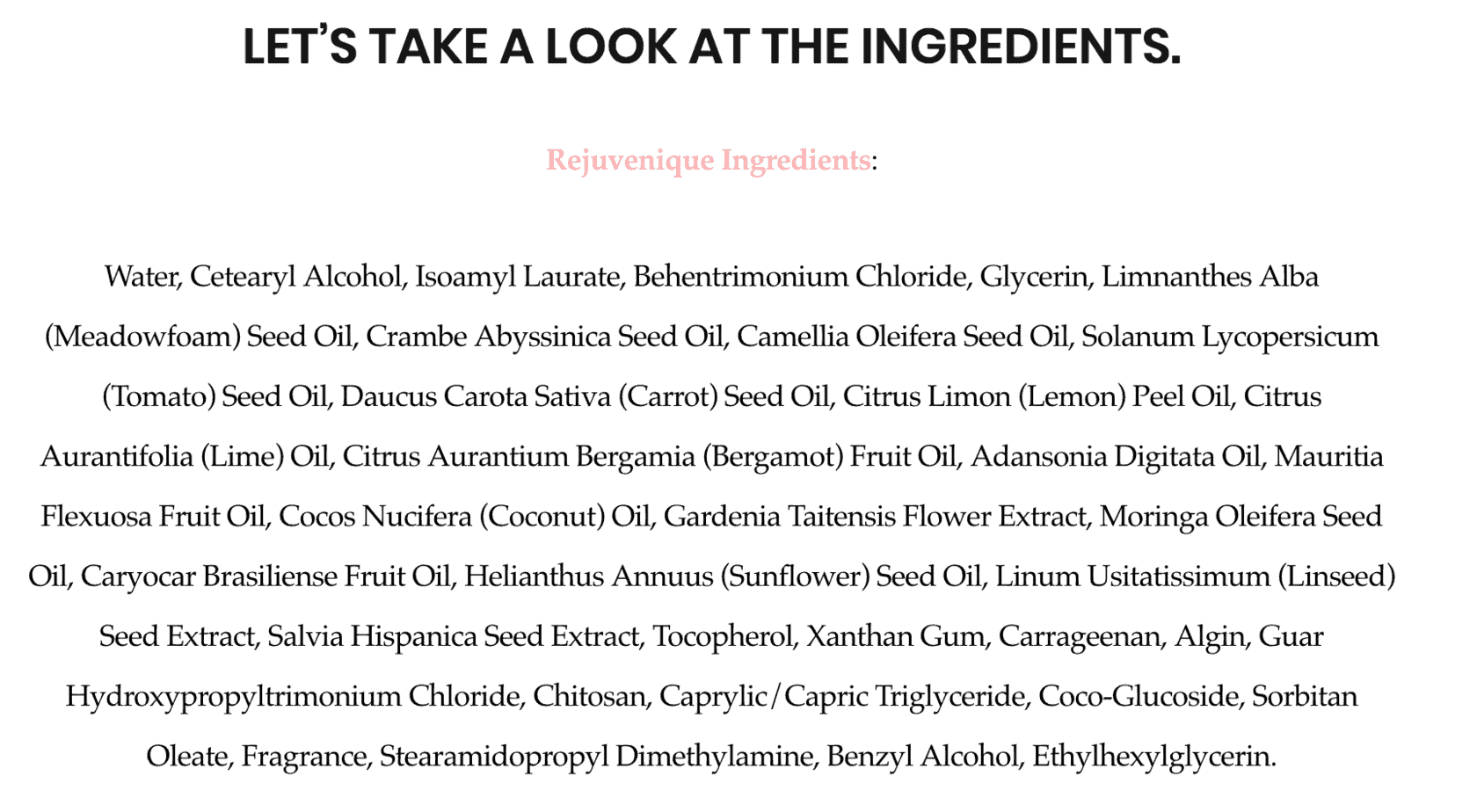
Those are the ingredients for the Rejuvabeads product, NOT the Rejuveniqe Oil.
She also wrote, “Fragrance is banned in Europe”. I commented on her Facebook page to let her know that is obviously false (just think of all the perfume that is made in Paris)… She has since deleted that line from her post.
However, she really needs to take the whole post down since there’s almost nothing factually correct in it, as I will outline below…
Ancestral Nutrition’s Bias
Also, I need to note here that although Ancestral Nutrition does not disclose this on her post, she does sell her own skincare and haircare products as you can see below.
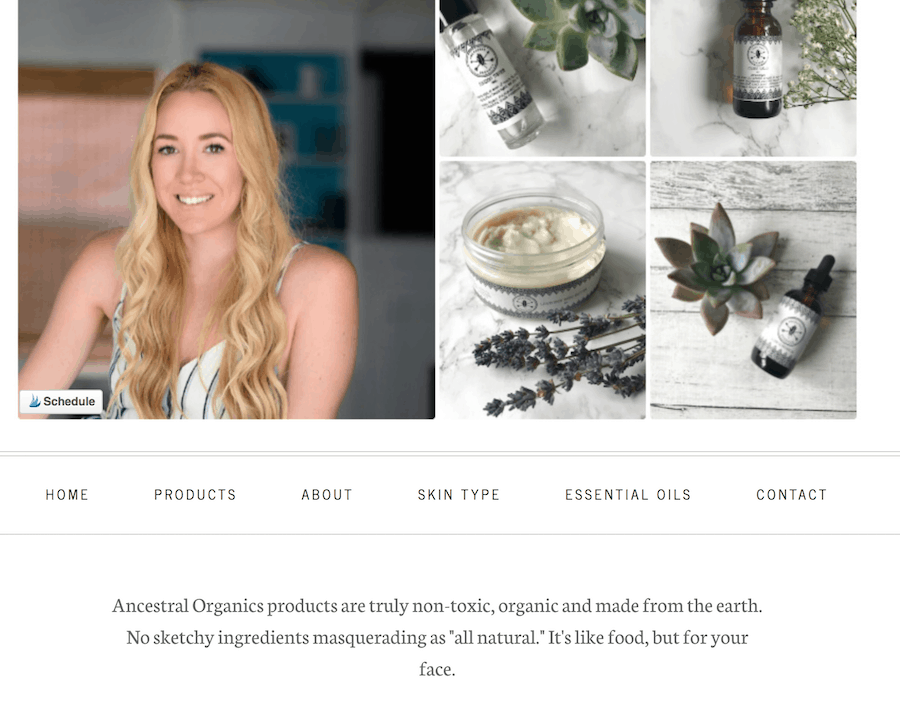
What this tells me is she’s biased because she is a competitor. All journalists and reviewers are biased, of course, but we need to always disclose these things so people are aware of the bias. Particularly when there is a financial interest. And especially when you title your blog post, “An Unbiased Review”.
OK… so let’s take a look at each one of her claims about MONAT ingredients and determine whether any of these complaints about MONAT products are legitimate.
1. Do MONAT Hair Products Contain Harmful Fragrances?
Do MONAT hair products contain harmful fragrances?
Nope. I debunked this in my original MONAT review.
In that post, I created a spreadsheet with all the ingredients in Renew Shampoo, and I specifically addressed the fragrances, which are all 3 and below on Skindeep.
Here is an excerpt from my MONAT review:
“If you look at the spreadsheet, you’ll notice that Fragrance (parfum) is listed and it scores an 8. That is Skin Deep’s rating for synthetic fragrance, so it doesn’t apply to MONAT. Personal care product companies are not required to list the ingredients in fragrances, and they can be very toxic.
However, I got a hold of all the ingredients MONAT uses in their fragrances, and they all score 3 or below. Here’s the spreadsheet.”
But even without that information included in my spreadsheet, we can debunk her claim based on the information she published in her own blog post.
She says, “Roughly 95% of all synthetic fragrance is derived from petroleum, crude oil.”
This is true. Most fragrances are made from petroleum and yes, they are toxic.
But MONAT does not use petroleum products of any kind in their formulations. Hence, based on logic, MONAT’s fragrance formulations are not petroleum-based.
Furthermore, note that although fragrance is allowed in Europe (see above), the EU is much more strict about which fragrance ingredients are allowed. There are many ingredients under the label of “fragrance” that are allowed in the US but banned in Europe.
This also debunks her claim because MONAT products are being sold in Europe and have been since February 2018. They just opened up the UK and they did not change their formulation at all. (See the second tab on my spreadsheet.)” What that tells you is these harmful fragrance ingredients are NOT contained in MONAT products.
Sorry, this spreadsheet was taken down during my time being censored by Big Tech. At some point I will try to reconstruct it.
2. Do MONAT Hair Products Contain PEGs, or Polyethylene Glycol?
According to Ancestral Nutrition’s blog post:
“While MONAT says they do not use PEGs in their products – it’s clearly a falsehood. Steareth-21 and Cetereath-20 are both on the ingredient list and made of polyethylene glycol, aka PEGs.”
First of all, no, MONAT does *not* contain PEGs. As with harmful fragrances, if MONAT products contained PEGs, they could not sell them in Europe.
Ancestral Nutrition is making the claim that Steareth-21 and Cetereath-20 are PEGs… but she has no proof of that. While these two ingredients CAN be PEGs, they are only PEGs if they are contaminated with ethylene oxide, which is carcinogenic (cancer-causing).
OK, I’m about to get science-y here, but stay with me… I’m not a scientist or a chemist… in fact, I didn’t even take chemistry in high school.
What Are PEGs?
But this is plain logic… All you have to do is read the definition of what a PEG is. You will see that there is no evidence that MONAT ingredients contain PEGs.
“ETHYLENE OXIDE: a known human carcinogen; banned in Canada and European Union; EWG rates it 10 for the harmful health impact on a scale from 0 to 10 (10 being the most harmful); associated with cancer, reproductive effects, mutagenic changes, neurotoxicity, and sensitization; not an ingredient but a contaminant of ingredients such as Polysorbate-20, Sodium Laureth Sulfate, PEG-100 Stearate, Ceteareth-20, Ceteth-20, Polysorbate-60, Laureth-7, PEG-40 Hydrogenated Castor Oil, Steareth-21 and others” (Source)
“CETEARETH-20: an emulsifying agent; may be contaminated with carcinogenic ethylene oxide (see ETHYLENE OXIDE) and 1,4-dioxane (see 1,4-DIOXANE)” (Source)
Note the words “MAY BE CONTAMINATED”.
Also read this definition of what a PEG is: “PEG is also known as polyethylene oxide (PEO) or polyoxyethylene (POE), depending on its molecular weight.”
So, polyethylene oxide is a PEG… but Steareth-21 and CETEARETH-20 are not necessarily contaminated with ETHYLENE OXIDE.
Steareth-21 and CETEARETH-20 Are Only PEGs if They Are Contaminated
Are you following? Therefore, there is no proof that Steareth-21 and CETEARETH-20 are PEGs. Steareth-21 and CETEARETH-20 are only PEGs if they are contaminated by ethylene oxide. They must be contaminated by ethylene oxide to be classified as a PEG. And there is no proof of that.
Furthermore, according to one of the Market Partners in my upline, MONAT does small batch manufacturing and tests at four different points for a number of different factors, including contamination of primary ingredients (such as Steareth-21 and Cetereath-20).
3. Do MONAT Hair Products Contain Behentrimonium Chloride?
Ancestral Nutrition writes:
“Behentrimonium chloride is an ammonium salt and while I found reports stating that it causes tissue death – I wasn’t able to find any studies to substantiate this claim. However, if you or your child have skin issues like eczema or psoriasis, it is best to avoid a harsh ingredient like this.
Behentrimonium chloride is only safe in concentration under 0.1% – as I was unable to reach Monat, I am unsure of what percentage they use in their products.”
What Is Behentrimonium Chloride?
What is behentrimonium chloride? It is a waxy solid made from colza oil, which comes from the seeds of Brassica rapa olifera. Also known as canola or rapeseed, Brassica rapa olifera, is part of the mustard plant family.
Behentrimonium chloride is rated as a 3 on the Skin Deep website, which means it is very low to moderate in terms of toxicity.

They consider anything between 0-2 to be non-toxic and 3-6 to be moderate; keep in mind, some essential oils score a 3 on the Skin Deep website. For example, natural lime oil scores a 3.
The Soft Landing blog, a website that I respect and recommend based on the quality of their research, says behentrimonium chloride is an “ingredient of mild concern”.
Read More About Behentrimonium Chloride
I found lots of other articles about Behentrimonium chloride, including this one from the website, I Read Labels For You:
“In the Skin Deep database, behentrimonium chloride is rated 3 with no data available. In the Canada Environment Substance List, it is listed as being non-persistent and non-bioaccumulative, but still toxic to aquatic life.
The European Scientific Committee on Consumer Safety found that behentrimonium chloride may cause irritation in concentrations above 5% in the rinse-out products and up to 3% in leave on hair care and facial cream products. Since these are relatively much higher thresholds than for other quats, such as cetrimonium chloride or steartrimonium chloride, we can probably assume that behentrimonium chloride is safer.
This study confirms that, unlike some other quats, this one does not cause either immediate dermal irritation or delayed sensitization (an allergic reaction developed over time) when used in concentrations >5%.
In conclusion, behentrimonium chloride has not been linked to any health problems when used in concentrations of under 5%. However, there is a concern about its safety to aquatic life.”
You can find Behentrimonium chloride in many other natural shampoos and hair products, including Shea Moisture, Herbal Essences, OGX and Deva Curl.
Okay, so I think it’s clear behentrimonium chloride is not an issue and clearly not toxic unless it is used in high concentrations… and there is no evidence of that in the Ancestral Nutrition post.
4. Do MONAT Hair Products Contain Stearamidopropyl Dimethylamine?
In the Ancestral Nutrition article, she says Stearamidopropyl Dimethylamine is in the Rejuvenique oil (see the screenshot above, where she got the ingredients wrong), which is applied to the skin.
This is false.
Stearamidopropyl Dimethylamine is in some MONAT products including Rejuvabeads. If you are familiar with the products, Rejuvabeads is something you ONLY use on the ends of your hair (it’s a split end mender). It is not something you put on your skin or on your scalp. And you also use a very tiny amount of it — maybe a pea size at most.
Stearamidopropyl Dimethylamine is also in the Blow Out Cream, Air Dry Cream and the Junior Detangler. But you will notice on the ingredients lists for those products, Stearamidopropyl Dimethylamine is at the bottom of the list. Which means there is very little of this ingredient in the products.
What Is Stearamidopropyl Dimethylamine?
I did some research on Stearamidopropyl Dimethylamine. It’s a 1 on the Skin Deep site, which means very low hazard.
In all the articles I read, they said it’s nothing to be scared of.
Check out this excerpt from an article from NaturallyCurly.com:
“Common Misconceptions
Stearamidopropyl dimethylamine sounds scary for two reasons: one, the -propyl ending is reiminiscent of isopropyl alcohol, that naughty drying alcohol that lends itself to snapping damaging and breaking natural hair.
Two, the dimeth- shares the same first 6 letters as dimethicone, a common silicone used in hair products. Anti-cone naturals may mistakenly associate this ingredient with a cone, when in fact, it is not.
In actuality, stearamidopropyl dimethylamine is touted as a silicone replacement, often used in place of or in conjunction with silicones in many conditioners. It is a cationic surfactant (positively charged) made from the rapeseed (more canola!).
What does it do
Stearamidopropyl dimethylamine binds to the hair, helps correct the negative charge of shampooing (like most conditioners), helps detangle, reduce flyaways and static, and helps smooth the cuticle. Unlike some silicones, it does not cause buildup.”
Waxes and silicones can build up on hair and cause the follicles to get blocked and slow hair growth. Build up is one of the things we really want to avoid with haircare products.
5. Do MONAT Hair Products Contain Benzyl Alcohol?
Yes, there is benzyl alcohol in MONAT products but this is not something to be concerned about, because the amount used is very small, and it is not irritating or toxic in tiny amounts.
From the Ancestral Nutrition article:
“In a primary irritation study 10% benzyl alcohol applied in a 24-hour occlusive patch to the back of eight male albino rabbits did not cause irritation.”
In other words, they put a patch containing 10% benzyl alcohol on rabbits and there was no irritation.
There is no way there is 10% benzyl alcohol in any MONAT product. This one is a non-starter.
But it is also important to note that benzyl alcohol can be derived from petrochemicals OR from natural sources. Since MONAT does not use petroleum products (see #1 above, under Harmful Fragrances?), it is safe to assume any benzyl alcohol comes from plant-based sources. Many plants, fruits, and teas actually have benzyl alcohol as a component, as do essential oils like jasmine, hyacinth, and ylang-ylang.
What this means is just because you find benzyl alcohol in a product does not mean it is toxic such as the benzyl alcohol derived from petroleum. If this were the case, you’d have to throw out all your essential oils.
6. Do MONAT Hair Products Contain Trifolium Pratense, or Red Clover Flower Extract?
Most of the MONAT hair products do contain red clover flower extract, however, this is not a toxic ingredient. Skin Deep gives it a 1, which means they consider it non-toxic.
Also, they are using EXTRACT, not the actual plant. Finally, it’s a tiny, tiny amount. Less than 1%. There are products on Amazon that have over 10%.
Listen to Dr. Jamie Ross, SVP of Technical Services and R&D at MONAT addresses the question about whether or not red clover extract is toxic at the 2018 MONAT conference in Washington D.C.:
Dr. Amy S. Ross, MD, Dermatologist specializing in Mohs Micrographic Surgery, also on the MONAT Scientific Advisory Board chimes in:
Dr. Brent Agin, MD, author of “Healthy Aging for Dummies” and “Super Foods for Dummies,” and on the Scientific Advisory Board at MONAT concurs:
For even more information on this ingredient, and why it’s perfectly safe, watch this video which explains it in plain English.
7. Do MONAT Hair Products Contain Centrimonium Chloride?
From Ancestral Nutrition’s post:
“Centrimonium chloride is an ammonium salt used as a preservative… At low doses, it is a skin irritant (source). At high doses…”
Again, not a high dose. And it’s a low to moderate hazard… a 3 on the Skin Deep website.
What Ingredients Should Not Be in Shampoo?
There are many ingredients to avoid in shampoo. Here’s a short list of 10 ingredients you should always avoid in hair care products.
1. Ammonium Lauryl Sulfate or Sodium Laureth Sulfate (SLES)
2. Sodium Lauryl Sulfate (SLS)
3. Parabens
4. Sodium Chloride
5. Polyethylene Glycols (PEG)
6. Diethanolamine (DEA)
7. Formaldehyde
8. Phtalates
9. BHT
10. Harmful (petroleum-based) fragrances
MONAT hair products do not contain any of the above ingredients.
What Is MONAT and Why Is It Different?
What is MONAT? Should you trust this company and this product line?
MONAT’s ingredients are naturally-based, safe, and sustainably sourced. What makes MONAT different is the ingredients. Not only are the mostly natural and plant-based, but is the way they are formulated to work that sets them apart and produces such great results for our customers.
The revolutionary ingredients in MONAT products are:
MONAT Ingredient: REJUVENIQE™ Oil Intensive
REJUVENIQE™ Oil, which is in most of the MONAT products, is a proprietary blend of 13+ unique ingredients. This blend is rich in vitamins, minerals, omega-6 fatty acids, antioxidants, beta-carotene, and amino acids. It is suitable for all skin and hair types.
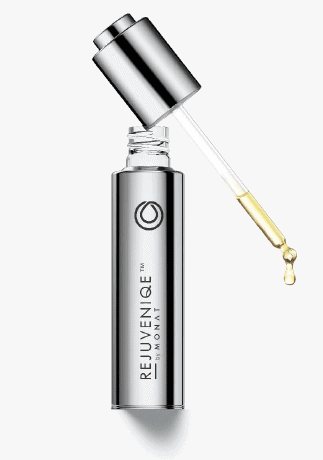
Many other brands are using botanical or plant-based oils. However, MONAT goes above and beyond. MONAT’s formulations are designed to allow these naturally-based ingredients to work synergistically with each other.
The ingredients in MONAT REJUVENIQE™ Oil mimic the body’s own natural oils which help to reduce hair thinning, prevent oxidative stress, and increase volume and shine. REJUVENIQE’s combination of oils energize and rehabilitate the scalp to visibly repair hair with instant and long-term benefits.
MONAT Ingredient: Capixyl™
Capixyl™, which is a red clover extract, is a gentle emollient that hydrates the scalp to help stimulate natural, noticeable hair growth. Clinical results show a significant decrease in hair loss and an increase in hair regrowth with Capixyl.
MONAT Ingredient: Procataline™
Procataline™ is made from pea extract, a rich plant-based source of secondary metabolites, which deliver healthy nutrients to promote hair growth. Procataline helps to maintain a healthy environment for hair growth, preserves and protects the hair follicle, aids in prevention of hair loss and helps protect against environmental damage.
MONAT Ingredient: Crodasorb™
Crodasorb™ is a powerful formula that helps to protect the hair from the sun’s harmful rays and UVB damage. In addition, Crodasorb preserves the hair’s natural pigmentation and locks in moisture. Finally, Crodasorb protects natural and synthetic coloring.
In Conclusion… Are the Ingredients in MONAT Hair Products Toxic?
Are MONAT hair products toxic? The answer is no. The ingredients in MONAT hair products are safe.
Clearly, there is zero evidence in this article by Ancestral Nutrition to prove that MONAT hair products are toxic in any way.
I think it’s extremely irresponsible for a blogger to attack products and a company like this when it is so completely unwarranted. Accusing MONAT products of causing cancer and birth defects is defamatory, as there is simply no evidence to validate these claims.
I’m the first in line to attack products that are unsafe and hazardous to health. But in order to do that, you have to actually prove that with facts. But she didn’t.
If anyone finds evidence that there are toxic ingredients in MONAT products, please comment below. I have yet to find anything anywhere on the internet.
On that note, I will be doing another post in this series to explore some of the other posts I have seen on social media about MONAT.
Learn More About MONAT Hair Products
Read my post: Monat Review: Why I Switched to MONAT Hair Products
Pin This Post: Are MONAT Hair Products Toxic? Debunking the Myths About MONAT Ingredients
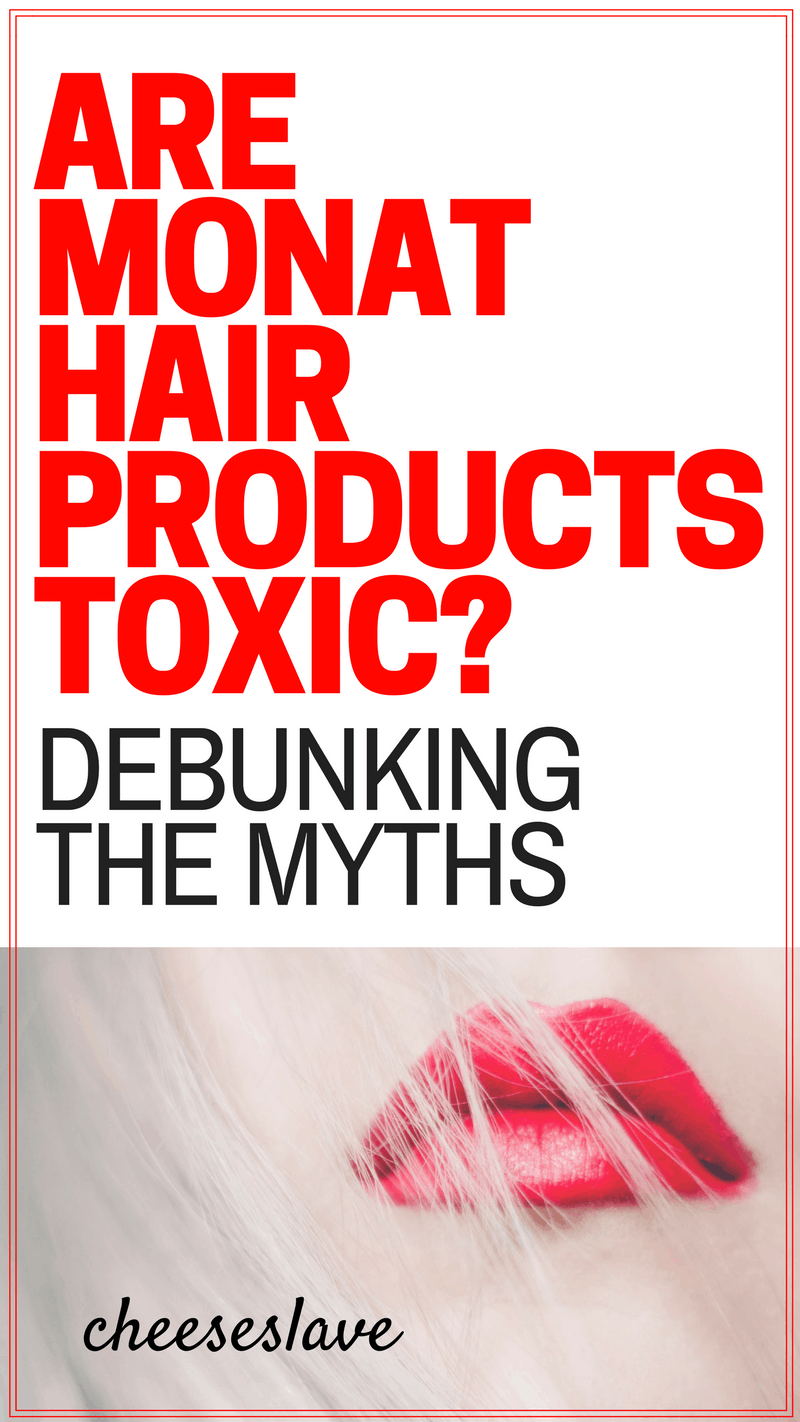



Comments ()